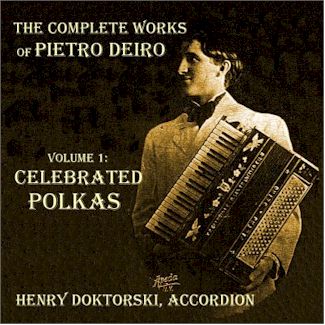CD Review: The Complete Works of Pietro Deiro Volume 1: Celebrated Polkas

Henry Doktorski, Accordionist |
Program:
|
Review by Robert W. Stead:
Which came first--the accordion or the polka? According to Henry Doktorski, the accordion precedes the polka--but not by much. As he states in the CD notes:
Both appeared right around the same date in history: the accordion was probably first patented in 1829 by the Viennese organ and piano maker Cyrill Demian and his sons, and the polka first appeared in 1830 in either Poland or Bohemia. From the beginning it seemed that the marriage of the accordion and the polka was a match made in heaven.
Another match made in heaven was the Brothers Deiro and the piano accordion. Pietro and his brother Guido were major forces in the accordion world in the first half of the twentieth century. In fact in the Spring of 1922 Guido Deiro did the first radio broadcast of a piano accordion here in my home town of Detroit, MI. While both Guido and Pietro were performing artists, Pietro Deiro's influence went well beyond the stage. He created a successful music publishing company and opened a chain of music studios throughout the East Coast. Pietro was also instrumental in establishing the American Accordion Association in 1938. To add to his credits, he commissioned and composed original music for the accordion.
Doktorksi has done extensive research on the Brothers Deiro and has made a mission of recording their music so that the accordion community will have a lasting aural record of their contribution to the instrument. He has already produced The Complete Works of Guido Deiro [see: CD Review: Vaudeville Accordion Classics: The Complete Works of Guido Deiro] under the auspices of Guido's son, Robert Deiro, and he now offers us the first of several future volumes of Pietro's work.
I must admit that when I returned to the accordion after being away from it for almost 40 years, I thought I would never play a polka. I felt that the polka limited both the image and the potential of the accordion. Before long, though, I found myself playing polkas because they are fun. The polkas presented here by Doktorski are both interesting and fun. Each has its own personality, and Henry brings all of his classical training and finesse into play to bring their personalities to life. I must admit that my favorite is the Celestina Polka. Someone once said that nobody has done for the polka what Astor Piazzolla did for the tango. While that is true, I think that Henry's interpretation of the Celestina Polka is a step in that direction. People complained that one could not dance to a Piazzolla tango. Well, one could not dance to the Celestina Polka polka either. It plays --in fact toys-- with the tempo and breaks the polka mold.
Several of the pieces are from Pietro Deiro's method books: "The Master Method for the Piano-Accordion" (1937), "Bellow Shake for the Accordion" (1937), and "The Little Accordionist, Vol 3" (1937). Although some are rather brief, and in some respects unfinished polkas [the Polish Polka is only 16 measures long], they are interesting. The Jubilee Polka in C major has a delightful trio in F minor based on the minor harmonic scale.
As mentioned above, Doktorski brings his classical training to the interpretation of these polkas. His phrasing is a delight and his choice of registrations add variety to the selections. I look forward to the release of "The Complete Works of Pietro Deiro Volume 2".
| About The Free-Reed Review |
| Invitation to Contributors / Submission Guidelines |
| Back to The Free-Reed Review Contents
Page |
| Back
to The Classical Free-Reed, Inc. Home Page |